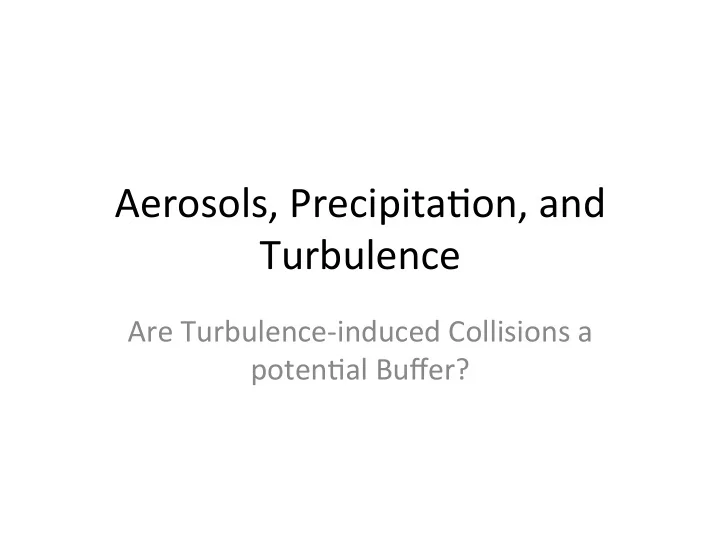

Aerosols, ¡Precipita/on, ¡and ¡ Turbulence ¡ Are ¡Turbulence-‑induced ¡Collisions ¡a ¡ poten/al ¡Buffer? ¡
Preliminary ¡Understanding ¡ • Ini/ally ¡precipita/on ¡is ¡ delayed ¡or ¡supressed… ¡ – Increase ¡Aerosols ¡ – Increases ¡CCN ¡ – Increases ¡N d ¡ – Decreases ¡precipita/on ¡ due ¡to ¡the ¡effect ¡on ¡ collision ¡efficiency. ¡
Complex ¡Rela/onship ¡ • Meteorology ¡is ¡important ¡ – Humidity ¡at ¡cloud ¡tops ¡ • Ackerman et al. 2004. The impact of humidity above stratiform clouds on indirect aerosol climate forcing. Nature 432 – Cloud-‑type ¡ – Wind ¡shear ¡ • Fan et al. 2009. Dominant role by vertical wind shear in regulating aerosol effects on deep convective clouds. J. Geophys. Res-Atmos. 114
Deep ¡Convec/on ¡ Deeper clouds Cooling More evaporation Warming Less precipitation More precipitation More cloud-active aerosol Figure 4 | The deepening effect. The local inhibition of precipitation helps precondition the environment for deeper convection, which then rains more. Stevens and Feingold. 2009. Untangling Aerosol Effects on Clouds and Precipitation in a Buffered System. Nature 461
Secondary ¡Cloud ¡Forma/on ¡ • In ¡the ¡presence ¡of ¡ moderate ¡wind ¡shear, ¡ squall ¡lines ¡and ¡ secondary ¡clouds ¡form ¡ as ¡a ¡result ¡of ¡ downdraP ¡mo/on’s ¡ reinforcement ¡by ¡ evapora/ve ¡cooling. ¡ Khain et al. 2005. Aerosol impact on the dynamics and microphysics of deep convective clouds. Q. J. R. Meteorol. Soc. 131 :2639–2663
Precipita/on ¡is ¡Delayed ¡ Khain et al. 2005. Aerosol impact on the dynamics and microphysics of deep convective clouds. Q. J. R. Meteorol. Soc. 131 :2639–2663 Figure 17. Time evolution of accumulated rain in the PRE-STORM thermodynamic conditions in maritime and continental aerosol cases.
APer ¡ini/al ¡delay… ¡ – Net ¡result ¡is ¡more ¡vigorous ¡convec/on. ¡ – Increased ¡turbulent ¡energy ¡and ¡dissipa/on ¡rate. ¡ – Net ¡precipita/on ¡efficiency ¡over ¡an ¡area ¡may ¡ decrease, ¡but ¡water ¡vapor ¡from ¡a ¡large ¡region ¡can ¡ be ¡concentrated ¡locally ¡into ¡strong ¡storms. ¡[Khain ¡ et ¡al. ¡2005] ¡ • Good ¡condi/ons ¡for ¡turbulent ¡droplet ¡ collisions! ¡
Turbulence ¡and ¡Rain-‑forma/on ¡ • Turbulent ¡enhancement ¡over ¡a ¡purely ¡ gravita/onal ¡collision ¡kernel ¡is ¡as ¡high ¡as ¡5 ¡for ¡ strong ¡turbulence. ¡ 1. Increased ¡turbulent ¡collision ¡efficiency ¡ 2. Increased ¡droplet ¡clustering ¡ 3. Modified ¡droplet ¡rela/ve ¡mo/on ¡ ¡
1. ¡Increased ¡Turbulent ¡Collision ¡ Efficiency ¡ ¡ Wang, LP., et al. Turbulent collision efficiency of heavy particles relevant to cloud droplets. New J. Phys. 10 (2008). Figure 9. Turbulent collision efficiencies for cross-size collisions. (a) a 1 = 20 µ m, (b) a 1 = 30 µ m and (c) a 1 = 50 µ m.
2. ¡Increased ¡Droplet ¡Clustering ¡ St = τ p τ κ τ p = d 2 ρ p / ρ air 18 ν air ⇥ 1 / 2 � ⇥ air ⇤ κ = � Walter C. Reade and Lance R. Collins. E ff ect of preferential concentration on turbulent collision rates. Physics of Fluids , 12(10):2530–2540, 2000.
3. ¡Modified ¡Droplet ¡Rela/ve ¡Mo/on ¡ elling 30(11):1326 – 1342 Wang L, Maxey M (1993) Settling velocity and concen- tration distribution of heavy particles in homogeneous isotropic turbulence. J Fluid Mech 256:27–68 Aliseda A, Hainaux F, Cartellier A, Lasheras J (2002) Ef- fect of preferential concentration on the settling velocity of heavy particles in homogeneous isotropic turbulence. J Fluid Mech 468:77–105 de Almeida FC (1976) The collision problem of cloud
Turbulence ¡and ¡Rain-‑forma/on ¡ • Enhancement ¡is ¡largest ¡for ¡drops ¡of ¡similar ¡ sizes ¡ – Effect ¡of ¡clustering ¡is ¡most ¡pronounced ¡for ¡ droplets ¡of ¡similar ¡size ¡(effect ¡of ¡Stokes ¡number) ¡ – Collision ¡efficiency ¡is ¡also ¡highest ¡for ¡similar ¡sized ¡ drops. ¡
Figure 2. (a) The ratio of a typical turbulent collision kernel to a purely gravitational collision kernel (Wang and Grabowski, 2009) for ε = 200 cm 2 s − 3 . The ratio on the 45 ◦ degree line is undefined owing to the zero value of the gravitational kernel. The ratio is essentially one when droplets are greater than 100 µ m. The constituent parts of the turbulent collision kernel are shown in (b) the droplet relative velocity, (c) the RDF and (d) the collision efficiency. Devenish et al. 2012. Droplet growth in warm turbulent clouds. Q. J. R. Meteorol. Soc. 138 :1401-129
Turbulent ¡Collision ¡Enhancement ¡ Factor ¡ a 1 ¡= ¡30 ¡microns ¡ h T ¡ a 2 / a 1 Wang L-P, Grabowski WW. 2009. The role of air turbulence in warm rain initiation. Atmos. Sci. Lett. 10 :1-8
Turbulent ¡Collision ¡Enhancement ¡ Factor ¡ Figure 3. The ratio of a typical turbulent collection kernel to the Hall kernel. The ratio on the 45 o degree line is undefined due to the zero value of the Hall kernel. The ratio is essentially one when droplets are above 100 µ m. The flow dissipation rate is 400 cm 2 /s 3 and rms velocity is 202 cm/s. Wang L-P, Grabowski WW. 2009. The role of air turbulence in warm rain initiation. Atmos. Sci. Lett. 10 :1-8
IPCC ¡AR5 ¡Chapter ¡7 ¡ ¡ 7.6.4 Effects of Aerosol–Cloud Interactions on Precipitation In summary, it is unclear whether changes in aerosol–cloud interac- tions arising from changes in the availability of CCN or IN can affect, and possibly intensify, the evolution of individual precipitating cloud systems. Some observational and modelling studies suggest such an effect, but are undermined by alternative interpretations of the obser- vational evidence, and a lack of robustness in the modelling studies. The evidence for systematic effects over larger areas and long time periods is, if anything, more limited and ambiguous.
Recommend
More recommend